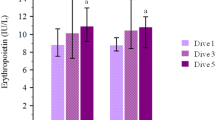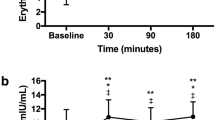Abstract
A reduction in haemoglobin concentration is consistently reported after deep saturation dives. This may be due to a downregulation of erythropoietin (EPO) concentration or to a toxic effect of the hyperoxia associated with the dives resulting in an increased destruction rate of erythrocytes. In this study haemoglobin concentration, blood cell counts, serum ferritin, bilirubin, haptoglobin and EPO concentrations were measured before, during and after a 19 day saturation dive to 240 m. The partial pressure of oxygen (PO2) was 35–70 kPa during the 7 day compression and bottom phase, and 30–50 kPa during the 12 day decompression phase. There was a reduction in EPO concentration from 8.4±1.4 (mean±1SD) to 6.3±1.9 U·L−1 on Dive day 2. On Dive days 7 and 17 EPO concentrations were not significantly different from baseline despite the continued exposure to hyperoxia. Immediately after the dive and return to a normoxic environment there was an increase in the EPO concencentration to 14.5±4.7 U·L−1. Haemoglobin concentration, erythrocyte and reticulocyte counts were decreased at the end of the dive, and there was an increase in serum ferritin. There were no changes in bilirubin or haptoglobin concentrations indicative of haemolysis. It appears that the change in PO2, rather than the sustained exposure to a hyperoxic environment, induces the changes in the EPO concentrations and erythropoietic activity.


Similar content being viewed by others
References
Berry CA (1973) A summary of medical experience in the Apollo 7 through 11 manned spaceflights. Aerospace Med 41:500–519
Bozzini CE, Barcelò, Conti MI, Martinez MP, Alippi RM (2003) Enhanced hypoxia-stimulated erythropoietin production in mice with depression of erythropoiesis induced by hyperoxia. High Alt Med Biol 4:73–79
Conway JM, Thorp JW, Stein TP, Seale JL, Rumpler WV (1995) Decreased protein synthesis during dry saturation diving. Undersea Hyperb Med 22:219–227
Domoto H, Nakabayashi K, Hashimoto A, Suzuki S, Kitamura T (2001) Decrease in platelet count during saturation diving. Aviat Space Environ Med 72:380–384
Doran GR, Chaudry L, Brubakk AO, Garrard MP (1985) Hyperbaric liver dysfunction in saturation divers. Undersea Hyperb Med 12:151–164
Eckardt KU, Boutellier U, Kurtz A, Schopen M, Koller EA, Bauer C (1989) Rate of erythropoietin formation in humans in respons to acute hypobaric hypoxia. J Appl Physiol 66:1785–1788
Embury SH, Garcia JF, Mohandas N, Pennathur-Das R, Clark MR (1984) Effects of oxygen inhalation on endogenous erythropoietin kinetics, erythropoiesis, and properties of blood cells in sickle-cell anemia. N Engl J Med 311:291–295
Erslev AJ, Wilson J, Caro J (1987) Erythropoietin titers in anemic, nonuremic patients. J Lab Clin Med 109:429–433
Gilman SC, Hunter WL, Mooney LW (1979) Changes in serum ferritin and other factors associated with iron metabolism during chronic hyperbaric exposure. Aviat Space Environ Med 50:223–226
Gilman SC, Biersner RJ, Piantadosi C (1982) Serum ferritin increases during deep saturation dives. Aviat Space Environ Med 53:1014–1016
Goldinger JM, Nakayama H, Takeuchi H, Hong SK (1987) Seadragon VI: A 7-day dry saturation dive at 31 ATA. VIII. Plasma enzyme profiles. Undersea Biomed Res 14:455–459
Hope A, Segadal K, Myking O, Ulvik R (2003) Fluid balance during a saturation dive to 2.6 MPa. In: Jansen EC, Mortensen CR, Hyldegaard O (eds) Proceedings of the 29th Annual Meeting of European Underwater and Baromedical Society. European Underwater and Baromedical Society, Copenhagen, p 139
Ikeda M, Nakabayashi K, Shinkai M, Hara Y, Kizaki T, Oh-ishi S, Ohno H (2004) Supplementation of antioxidants prevents oxidative stress during a deep saturation dive. Tohoku J Exp Med 203:353–357
Jaskunas SR, Stork EJ, Richardson B (1973) Effects of a hyperoxic environment on erythropoietin production. Aerospace Med 44:1112–1116
Kaplan SM, Piliero SJ, Gordon AS, Meagher R (1977) Mechanisms underlying the suppression of erythropoiesis by hyperoxia. Am J Med Sci 273:71–77
Klausen T, Christensen H, Hansen JM, Nielsen OJ, Fogh-Andersen N, Olsen NV (1996) Human erythropoietin response to hypocapnic hypoxia, normocapnic hypoxia and hypocapnic normoxia. Eur J Appl Physiol 74:475–480
McMahon FG, Vargas R, Ryan M, Jain AK, Abels RI, Perry B, Smith IL (1990) Pharmacokinetics and effects of recombinant human erythropoietin after intravanous and subcutaneous injections in healty volunteers. Blood 76:1718–1722
Means RT, Krantz SB (1992) Progress in understanding the pathogenesis of the anemia of chronic disease. Blood 80:1639–1647
Milledege JS, Cotes M (1985) Serum erythropoietin in humans at high altitude and its relation to plasma renin. J Appl Physiol 59:360–364
Moon RE, Fawcett TA, Exposito AJ, Camporesi EM, Bennett PB, Holthaus J (1992) Platelet count in deep saturation diving. Undersea Biomed Res 19:279–286
Murray RD, Jacey MJ (1977) Shallow habitat air dives I and II: Human hematologic responses to compressed air saturation diving. Aviat. Space Environ Med 48:1012–1017
Nakabayashi K, Mizukami H, Hashimoto A, Oiwa H (1991) Change in red cell production rate during a 330 msw saturation dive simulation (abstract). Undersea Biomed Res 18(suppl):32
Park YS, Claybaugh JR, Shiraki K, Mohri M (1998) Renal function in hyperbaric environment. Appl Human Sci 17:1–8
Singh A, Eckardt KU, Zimmermann A, Gotz KH, Hamann M, Ratcliffe PJ, Kurtz A, Reinhart WH (1993) Increased plasma viscosity as a reason for inappropriate erythropoietin formation. J Clin Invest 91:251–256
Spivak JL (1993) The clinical physiology of erythropoietin. Semin Hematol 30(suppl 6):2–11
Spivak JL, Pham T, Isaacs M, Hankins WD (1991) Erythropoietin is both a mitogen and a survival factor. Blood 77:1228–1233
Thorsen E, Haave H, Hofsø D, Ulvik RJ (2001) Exposure to hyperoxia in diving and hyperbaric medicine–effects on blood cell counts and serum ferritin. Undersea Hyperb Med 28:19–23
Tsangaris H, Pneumatikos J, Sdranis J, Frangides C, Nakos G (1999) The effect of hyperoxemia on erythropoietin secretion in anaemic patients. Monaldi Arch Chest Dis 54:120–125
Walle AJ, Wong GY, Clemons, Garcia JF, Niedermayer W (1987) Erythropoietin- hematocrit feedback circuit in the anemia of end-stage renal disease. Kidney Int 31:1205–1209
Worwood M (1986) Serum ferritin. Clin Sci 70:215–220
Wulff H, Wichmann HE, Pantel K, Loeffler M (1989) A mathematical model of erythropoiesis in mice and rats. Part 3: Supressed erythropoiesis. Cell Tissue Kinet 22:51–61
Acknowledgements
This study was supported by the Stolt-Halliburton Joint Venture, The Petroleum Safety Authority Norway, Norsk Hydro, Esso Norge and Statoil. We are grateful for the careful collection of blood samples by Randi Solheim, the analyses of EPO by Ole Myking, and the support of John Hjelle as medically responsible for the diving operation. Thanks to the divers and control subjects.
Author information
Authors and Affiliations
Corresponding author
Rights and permissions
About this article
Cite this article
Hofsø, D., Ulvik, R.J., Segadal, K. et al. Changes in erythropoietin and haemoglobin concentrations in response to saturation diving. Eur J Appl Physiol 95, 191–196 (2005). https://doi.org/10.1007/s00421-005-1381-9
Accepted:
Published:
Issue Date:
DOI: https://doi.org/10.1007/s00421-005-1381-9




